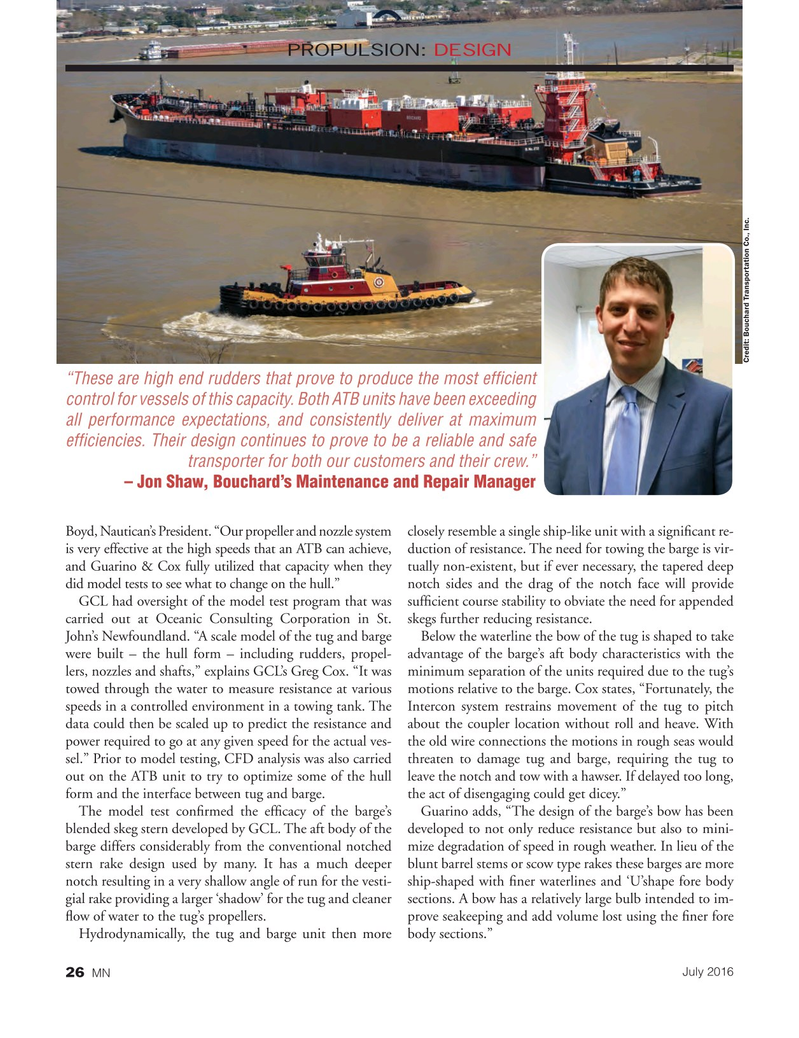
Page 26: of Marine News Magazine (July 2016)
Propulsion Technology
Read this page in Pdf, Flash or Html5 edition of July 2016 Marine News Magazine
PROPULSION: DESIGN
Credit: Bouchard Transportation Co., Inc. “These are high end rudders that prove to produce the most ef? cient control for vessels of this capacity. Both ATB units have been exceeding all performance expectations, and consistently deliver at maximum ef? ciencies. Their design continues to prove to be a reliable and safe transporter for both our customers and their crew.” – Jon Shaw, Bouchard’s Maintenance and Repair Manager
Boyd, Nautican’s President. “Our propeller and nozzle system closely resemble a single ship-like unit with a signi? cant re- is very effective at the high speeds that an ATB can achieve, duction of resistance. The need for towing the barge is vir- and Guarino & Cox fully utilized that capacity when they tually non-existent, but if ever necessary, the tapered deep did model tests to see what to change on the hull.” notch sides and the drag of the notch face will provide
GCL had oversight of the model test program that was suf? cient course stability to obviate the need for appended carried out at Oceanic Consulting Corporation in St. skegs further reducing resistance.
John’s Newfoundland. “A scale model of the tug and barge Below the waterline the bow of the tug is shaped to take were built – the hull form – including rudders, propel- advantage of the barge’s aft body characteristics with the lers, nozzles and shafts,” explains GCL’s Greg Cox. “It was minimum separation of the units required due to the tug’s towed through the water to measure resistance at various motions relative to the barge. Cox states, “Fortunately, the speeds in a controlled environment in a towing tank. The Intercon system restrains movement of the tug to pitch data could then be scaled up to predict the resistance and about the coupler location without roll and heave. With power required to go at any given speed for the actual ves- the old wire connections the motions in rough seas would sel.” Prior to model testing, CFD analysis was also carried threaten to damage tug and barge, requiring the tug to out on the ATB unit to try to optimize some of the hull leave the notch and tow with a hawser. If delayed too long, form and the interface between tug and barge. the act of disengaging could get dicey.”
The model test con? rmed the ef? cacy of the barge’s Guarino adds, “The design of the barge’s bow has been blended skeg stern developed by GCL. The aft body of the developed to not only reduce resistance but also to mini- barge differs considerably from the conventional notched mize degradation of speed in rough weather. In lieu of the stern rake design used by many. It has a much deeper blunt barrel stems or scow type rakes these barges are more notch resulting in a very shallow angle of run for the vesti- ship-shaped with ? ner waterlines and ‘U’shape fore body gial rake providing a larger ‘shadow’ for the tug and cleaner sections. A bow has a relatively large bulb intended to im- ? ow of water to the tug’s propellers. prove seakeeping and add volume lost using the ? ner fore
Hydrodynamically, the tug and barge unit then more body sections.”
July 2016
MN 26
MN July16 Layout 18-31.indd 26 6/20/2016 3:56:45 PM

 25
25

 27
27
